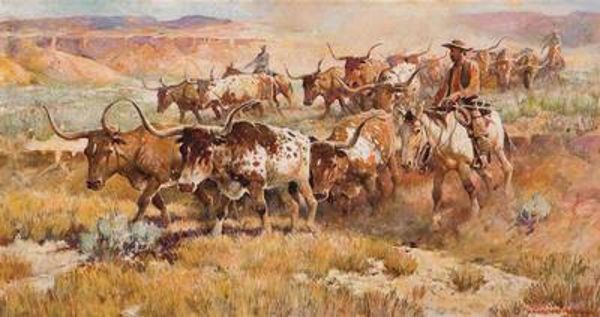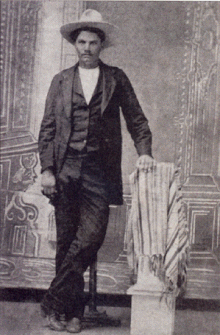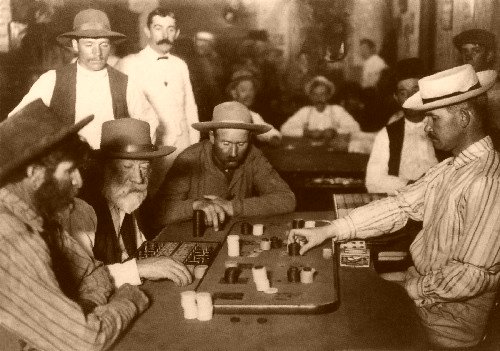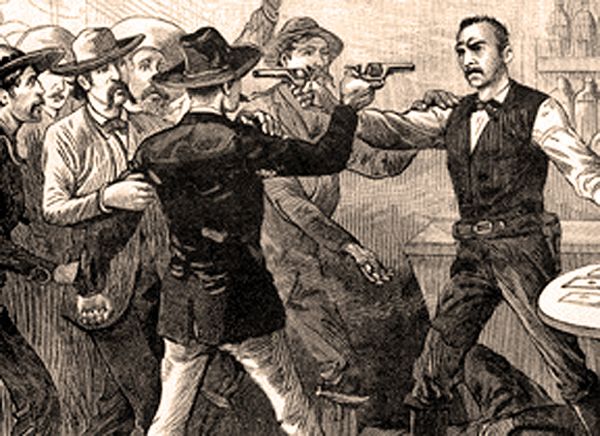
Newton, Kansas - 1871
Growing like a weed, Kansas becomes part of the United States of America with President Thomas Jefferson's purchase from Napoleon Bonaparte of the Louisiana Territory in 1803 for $15,000,000 ... a very wild part (the southwest portion of the future state will be part of Spain, then Mexico, then the Republic of Texas until the conclusion of the Mexican-American War concludes in 1848). Still homeland to thousands of free ranging Indians, the area is part of the Missouri Territory from 1812 to 1821, then, with the passage of the Kansas-Nebraska Act of 1854 it becomes the Kansas Territory (while its neighbor becomes Nebraska), a war ground for abolitionists and pro-slavers to battle each other that earns the area the nickname of "Bleeding Kansas." On January 29, 1861, just before the start of America's Civil War, Kansas is welcomed into the Union as a free state, the country's 34th. Civil War over by 1865 (and craziness like former schoolteacher William Clarke Quantrill's rape and pillage of the town of Lawrence), with the westward expansion of the Atchison, Topeka and Santa Fe Railway west from Emporia, the city of Newton is founded in 1871 and quickly becomes an important market for shipping Texas cattle from the end of the Chisholm Trail to the rest of the United States (the city is named for Newton, Massachusetts, the former home of some of the local stockholders in the railroad). It also becomes a violent gathering place (a famous statement of the time is that "... there is no Sunday west of Newton and no God west of Pueblo) for cowboys, railroad workers, buffalo hunters and soldiers requiring hard lawmen capable of answering force with force. Two of its hardest cases are William "Billy" Bailey and Mike McCluskie.

Santa Fe Railroad Depot - Emporia
An Irishman from Ohio, McCluskie comes to Kansas by way of working for the Santa Fe Railroad as a no nonsense foreman and a night policeman (earlier in the year he is charged with garroting a man to death, but the charges are dismissed). A Texas cowboy and gambler rumored to have killed two men in three gunfights, Billy Bailey arrives in town after trailing a herd of cattle to the new town. Politics heating up in the area as the town debates an August election in which the creation of new county with Newton as its hub is on the ballot, the pair are hired as Special Policemen to keep law and order in the town at night, but they clash almost immediately over politics and a local woman. Seemingly arguing all the time, the men's feud, fueled by massive amounts of drinking by both parties, finally explodes into violence on August 11, 1871. Disagreeing about the election, Bailey begins his day by badgering election officials and being generally obnoxious to everyone he meets ... McCluskie is having none of it though and administers a coarse tongue lashing to his "partner." Going their own ways the rest of the day, at around 8:00 in the evening, the men begin shouting at each other again in downtown Newton's Red Front Saloon when Bailey orders the Irishman to set up a round of drinks, which McCluskie of course refuses to do. Yelling not enough, the men soon go to "Fist City," and even bare knuckle antics are not enough to placate the combatants. Knocked through the saloon's front swinging doors by a massive McCluskie punch that comes after Bailey misses with a right cross, the Texan is pulling himself up from the dusty street when his opponent follows up his assault by leaving the bar, pulling his pistol, and firing two slugs at the Texas gambler, who takes a mortal round to the chest (Bailey will pass away the next day). Fearing he will be arrested and maybe hang for the killing, McCluskie flees town (taking the train northeast to the town of Florence) as many of the well-liked Bailey's cowboy friends vow revenge for the killing. Gone only a few days, McCluskie foolishly returns to Newton when he receives information that the shooting will be considered self-defense. Waiting for McCluskie in Newton are Hugh Anderson and several of his Texas friends.
Texan Cowboys On The Chisholm Trail
Anderson
Hugh Anderson is born in DeWitt County, Texas on November 25, 1851 to rancher Walter Pool "Wat" Anderson and his wife, Louisiana "Lou" Bailey Anderson. The third of ten children, Hugh grows up learning the cowboy skills required to make a successful life in the cattle business. In 1871, the 19-year-old Anderson leads a herd of his father's cattle north along the Chisholm Trail to Newton, Kansas. Also moving along the trail that summer is the notorious gunman, John Wesley Hardin. Befriending the fellow Texan as the men ride north, Anderson breaks off from his herd duties and along with Jim Rodgers and John Cohron, joins Hardin in tracking down and killing (Hardin does the actual shooting while the other men make sure their victim has no way of escaping from Bluff City, Kansas) Mexican gunman Juan Bideno (for the murder of Cohron's brother, Bill). Reaching Newton, Anderson is enraged to hear about the death of his friend, Bill Bailey, and vows revenge on McCluskie should their paths ever cross in the future ... a future that arrives on August 19, 1871,when the big railroad cop returns to Newton.

Cattle Drive North

Hardin
Returning to Newton for a Saturday night of gambling and drinking fun, McCluskie, accompanied by his friend, Jim Martin, enters the wild portion of Newton south of the train tracks known as Hide Park (named for the female inhabitants of the area willingness to strip down to their birthday suits, showing all of their "hide"), and decides to party at the faro tables in a saloon called Tuttle's Dance Hall (named for owner Perry Tuttle). Saturday merging into Sunday, sensing trouble could take place any second with McCluskie in his bar, at around 1:00 in the morning, Tuttle shuts down the band playing music and tries to close his business early, but the crowd inside the saloon is having none of it and the dance hall stays open ... shortly thereafter, three Texas cowboys, Billy Garrett (who has already both of the gunfights he's been in), Henry Kearnes, and Jim Wilkerson enter the bustling establishment and wait for Hugh Anderson to arrive, two at the bar and one at a corner faro table where McCluskie is playing. Shortly after 2:00 am, Anderson arrives and with pistol in hand walks directly up to the man he has vowed to kill, cursing, "You are a cowardly son-of-a-bitch. I will blow the top of your head off!" Talk time over, Jim Martin jumps up from his seat trying to stop the gunplay he sees coming but it is too late as Anderson tries to shoot his target in the head, but hits McCluskie in the neck instead. Blood spurting from what will prove to be a fatal wound, McCluskie half rises out of his chair and draws his weapon, but his first pull of the trigger, aimed at Anderson's chest, is a misfire ... unlike his victim, Anderson's revolver is performing quite nicely, and his next slug hits McCluskie in the leg. Down to the floor, as McCluskie tries to rise, Anderson puts several more rounds into his target's back.

Playing Faro

Gunplay
At this point, lots of guns come out of their holsters and begin firing! Poor lighting and smoke everywhere, the three Texan Cowboys fire their weapons trying to keep the crowd away from Anderson. Across from them, standing near the bar's entrance, a friend of McCluskie, a 18-year-old consumptive, dying of tuberculosis, named Jim Riley pulls two Colt .45 revolvers and begins firing at the Texans. The next victim of all the lead flying through the air is Jim Martin, the man that tried to stop the fight and as a reward for jumping out of his seat, takes a mortal bullet in the neck (a fatal jugular vein hit), runs out of the saloon and drops into the dust outside the nearby Alamo bar. More fatalities coming, Texas cowboy Billy Garrett is shot in the chest and shoulder (he dies a few hours later), Texas cowboy Henry Kearns suffers a chest wound that claims his life a few weeks later, and innocent bystander, Santa Fe railroad brakeman Patrick Lee is plugged in the stomach and dies two days later. Wounded in the melee are Texas cowboy Jim Wilkerson in the nose and leg, Hugh Anderson is struck twice in the leg, and a Santa Fe railroad employee crew chief named Hickey is shot in the left calf. His revolvers emptied, Riley holsters his weapons, walks out of the saloon unscathed, and is never seen again.

Hide Park Gunplay
1871 Shootout In Newton Kansas - Frederick
Remington
Wounded removed from the bar, there are too many deaths for the town to not take action, and the next morning, bright and early (8:00 am), town coroner C. S. Bowman holds a four and a half hour inquest that determines that Martin has died at the hands of an unknown assailant, but that McCluskie is dead at the hands of Anderson. Facing the possibility of being lynched or going on trial for murder, the future looks bleak for Anderson until his rich father arrives in town. Greasing the right palms, Anderson's father meets with local Newton businessmen that include the town doctor and a judge, and a plan is soon concocted to sneak the teenage gunman out of Kansas. On a conveniently rainy night, at 2:00 in the morning, Anderson is taken on a litter from the back of the Hoff store where he has been recuperating, walked down to the railroad depot, and with the knowledge of the conductor, locked in a room closet that isn't opened until the train reaches Kansas City, Missouri. Back in Texas, Anderson slowly recovers and by 1873, thinking the McCluskie matter has been forgotten, he is ready for some more Kansas adventure. A serious error, the McCluskie matter hasn't been forgotten at all by the railroad cop's brother, Arthur.

The Chisholm Trail
Feelers out all over the state, in June of 1873 McCluskie receives word that Anderson can be found in the ramshackle town of Medicine Lodge, Kansas, tending bar at an establishment called Harding's Trading Post. Vengeance now in sight, McCluskie hires a guide named Richards to take him to Medicine Lodge. Arriving in town on the Fourth of July, McCluskie challenges Anderson to a formal duel, which the Texan accepts ... and as the challenged, chooses pistols over Bowie knives. Grimly announcing he has a "chore to do," Anderson enlists his boss as his second and then closes the saloon earlier. Just before dusk, in front of a crowd of about a hundred individuals (most bombed with celebrating the country's birthday, and openly wagering on the outcome of the duel), backs turned to each other, the men are placed twenty paces apart, and at the sounding of a signal shot, whirl around and fire at each other. First shots too hurried by each man, McCluskie takes better aim with his second round, crumpling Anderson to his knees with a bullet that breaks Anderson's arm. But Anderson is not out, and shifting his gun to his other hand, he puts a slug into his adversary's mouth. Momma bear crazy, howling as he spits out blood and teeth, McCluskie charges forward, but the Texan finally brings him down with bullets to te man's leg and stomach. Fight seemingly over, after the stillness of a few split seconds, McCluskie suddenly rears up and shoots Anderson in the stomach, a hit that sends the cowboy over on his back. Murder vow not yet fulfilled, covered in blood, pulling his Bowie knife, McCluskie then begins crawling towards Anderson as a few members of the crowd call for the fight to end. Harding however yells for the combat to continue, and as the blood thirsty celebrants watch, the final acts of the duel play out. Sitting up as McCluskie reaches him, also armed with a Bowie knife, Anderson slashes forward and cuts the railroader's neck open, a fatal wound that McCluskie responds to by ramming his knife into Anderson's side. Combat completed, the men relax into death and bleed out on the street. Or at least that is how the story goes for the "... print the legend ..." point of view.
Bowie Knife
A different story though emerges in which reality is not even close to the famous duel tale. Surviving the gunfight and escape arranged by his wealthy father, Hugh Anderson returns to Texas and becomes a law abiding citizen. On July 11, 1872 in Bell County, Texas, Anderson marries 22-year-old Amanda Tomlinson. The couple celebrate the birth of their first child, Oscar, in May of 1873. Three years later, after his 1873 death is reported, Anderson becomes a widower, and with his son in tow, moves to McCullock, Texas with members of his family. In 1880, according to the Federal Census, 28-year-old Anderson is living in the McCullock area, working as a "stock rancher" and living with now 7-year-old Oscar. 1884 has the cowboy getting a new wife, Mag Cooke ... and this time he sets up camp in Chaves County, New Mexico, again as a stock man. The new couple has two girls, but again Anderson becomes a widower, the second time taking place in 1900. Ten years later, Anderson is still working cattle and living with his married son, Oscar's wife, and his three grandsons. Death finally comes for him in 1914 at the age of 62 ... no bullets or dagger knife slashes this time, on June 9, trying to take refuge from a major storm, Anderson shelters under a tree which is struck by lightning, killing the one-time gunman immediately. Now me, I prefer the blood duel tale, but whichever ending really happened, rest in peace Mr. Anderson!!!!!!!!!!!!
Newspaper

Gunfight By N.C. Wyeth
Great Story.
ReplyDelete